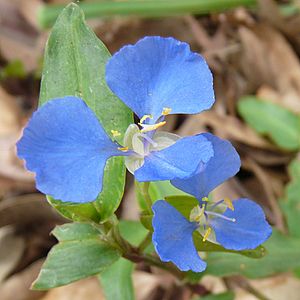Native wandering jew facts for kids
Quick facts for kids Native wandering jew |
|
|---|---|
 |
|
| Scientific classification | |
| Genus: |
Commelina
|
| Species: |
cyanea
|
Scurvy Weed (scientific name: Commelina cyanea) is a cool plant that grows close to the ground. It's a type of herb that lives for many years. You can find it in the wet forests and woodlands of eastern Australia, Lord Howe Island, and Norfolk Island. This plant is known for its pretty blue flowers, which bloom during the warmer parts of the year. Bees and flies help to pollinate these flowers, which means they help the plant make seeds.
Contents
What's in a Name?
The Scurvy Weed got its official scientific name, Commelina cyanea, a long time ago. A botanist named Robert Brown first described it in 1810. The plant still uses the same name he gave it!
The first part of its name, Commelina, comes from another plant called the Asiatic dayflower. A famous scientist named Linnaeus chose this name to honor two Dutch botanists, Jan and Caspar Commelijn. He thought the two large, bright petals of a similar plant looked like the two brothers.
The second part of the name, cyanea, is a Latin word that means "blue." This makes sense because of the plant's beautiful blue flowers.
Besides Scurvy Weed, people also call this plant by other names like native wandering Jew, forget-me-not, and creeping Christian. Its leaves can look a bit like ivy, and it has long, trailing branches.
What Does it Look Like?
Scurvy Weed is a plant that trails along the ground. Its stems can grow quite long. When the stems touch the soil, they can easily grow new roots. This helps the plant spread out. The plant's stems and leaves usually die back in winter.
Its leaves are shaped like an oval or a narrow oval. They are about 2 to 7 centimeters (0.8 to 2.8 inches) long. They are also about 0.5 to 1.5 centimeters (0.2 to 0.6 inches) wide.
The flowers of the Scurvy Weed can appear any time from spring to autumn. They are a deep blue color and are about 1.5 centimeters (0.6 inches) across. After the flowers, small capsules grow. These capsules hold 2 to 5 tiny seeds, which are about 2 to 3 millimeters long.
Where Does it Grow?
You can find Scurvy Weed in eastern New South Wales, Australia. It grows from a town called Narooma all the way up into Queensland. It also lives on Lord Howe Island and Norfolk Island. This plant likes to grow in wet, shady spots within forests.
Scurvy Weed's Friends and Foes
Scurvy Weed flowers are pollinated by many different native bees. These include bees like Nomia aurantifer and Amegilla pulchra. Other types of bees, called halictid and colletid bees, also help. Some flies, like those from the genus Syritta, also visit the flowers.
Animals like wallabies and rabbits enjoy eating the leaves and stems of the Scurvy Weed. It's also possible that water helps to spread the plant's seeds to new places.
How Do People Use It?
The leaves of the Scurvy Weed can be eaten as a vegetable. Early European settlers in Australia used the leaves to help with a sickness called scurvy. This is how the plant got its common name, Scurvy Weed.
Scurvy Weed is also a nice plant for gardens because of its pretty flowers. It can be grown as a groundcover, which means it spreads out over the ground. It also looks good in hanging baskets. It's very easy to grow new plants from cuttings.
Sometimes, Scurvy Weed can be confused with an introduced weed called wandering Jew (Tradescantia fluminensis). However, the wandering Jew has white flowers and stems that break easily. It also has weak roots and doesn't have the hairy leaf parts that Scurvy Weed has. Even though Scurvy Weed is native, it can sometimes grow a bit too much in gardens and become a minor weed itself.

